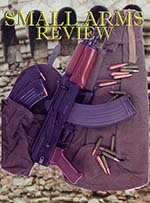Canadian Machine Gun Badges: 1914-1920
By Robert G. Segel
The first great conflict of the twentieth century (1914-1918) was known by several names: The Great War, The War To End All Wars and ultimately as World War I. When Great Britain declared war on Germany in August 1914, Canada, as part of the British Empire, decided to commit an initial force of 25,000 men to serve overseas. A second force was developed in the fall of 1914. The 1st Canadian Division was formed from those men in the original force in January 1915 and was shipped to France to fight the following month. The Canadian Corps were formed in September 1915 using elements from the 1st and 2nd Canadian Divisions as well as the Canadian Cavalry Brigade. The Canadian Machine Gun Corps was formed at that time and was patterned after the British Machine Gun Corps. The Canadian army, called the Canadian Expeditionary Force (C.E.F.), eventually grew to a total of over 600,000 of which about 425,000 served overseas.
Of special historical note was the creation of the Canadian Motor Machine Gun Brigades. The idea of an armored automobile combined with a machine gun was the brainchild of Raymond Brutinel, a former Captain in the French Army Reserve, who immigrated to Canada from France before World War I and became independently wealthy from his business dealings in Canada. Brutinel, along with a prominent lawyer friend by the name of Clifford Sifton, convinced the Minister of Militia that this was a viable consideration and that this Brigade could be established with the use of private funding. (Private funding of units by individuals or companies was a common practice of the time.) With the Minister of Militia’s blessing Brutinel went to the Colt factory in Connecticut and ordered 24 Colt Model 1895 Automatic Guns since the British Vickers were not yet available to the Canadians at that time. He then traveled to Pennsylvania to the Auto Car Company and bought some vans and from there went to the Bethlehem Steel Company to purchase boiler plate 9.5mm thick to be used as armor plate.
Brutinel then returned to Canada to design the bodies that would be fitted to the truck’s chassis. The Colt Model 1895’s were mounted on a pedestal so that it could fire over the sides of the armor plate. This first armored car weighed in at 3 tons, had a maximum speed of 25mph and had a crew of eight. It was the world’s first armored vehicle. Later refinements in armor and vehicle choice further enhanced its operational capabilities.
The Automobile Machine Gun Brigade, C.E.F. was mobilized on September 15, 1914 and consisted of the 1st and 2nd Sifton Batteries. The brigade was under the command of now Major Brutinel and consisted of 10 officers and 124 other ranks and was equipped with 8 armored cars, 24 Colt machine guns, 8 trucks and 4 automobiles. The Automobile Machine Gun Brigade later became the 1st Canadian Motor Machine Gun Brigade. (It was disbanded on November 15, 1920.) Very shortly afterwards, three more batteries were raised, also by private funding. The batteries were called the Eaton Motor Machine Gun Brigade, Bordon Motor Machine Gun Brigade and Boyle’s Yukon Territory (YT) Motor Machine Gun Brigade. (Eaton’s is a department store chain in Canada that is still in business to this day.)
The brigades went overseas but their mobile role initially went underutilized due to the static trench warfare that was prevalent at that time. It wasn’t until 1918 during the German breakthrough that the armored motorcar proved its mettle. Though Brutinel’s concept was for the armored cars to be in the forefront of an attack it was in a defensive role that it ultimately met its expectations of mobility and firepower.
The Canadian Machine Gun Corps was modeled on the British Machine Gun Corps and their insignia was initially the same using the crossed Vickers under the King’s crown on their badges. However, they soon added a “Canada” banner beneath the guns as a point of national pride. However, at the beginning of the war, the Canadians did not have access to the British Vickers Mk I machine guns so they used the Colt Model 1895 Automatic Guns. Captain Herbert McBride, an American who went to Canada and fought with the 21st Battalion of the 2nd Canadian Division, wrote in his two classic books “A Rifleman Went to War” and “The Emma Gees” about his early use of the Colt Model 1985 and how reliable and accurate it was under combat conditions even to the extent of being able to snipe single shot with it due to its easy gait of 400 rounds per minute rate of fire. As the war wore on and British production got into full swing, the Canadians ultimately were able to replace the Colt with the Vickers Mk. I water-cooled machine gun. This is why some Canadian badges show the Vickers while others show the Colt. It is also interesting to note that the machine gun image on the Canadian M.G.C. badge, like the British M.G.C. badge, evolved beginning with the early British Maxim and then through to the Vickers Mk. I.
The cap, collar and shoulder badges of the Canadian Machine Gun Corps and the Canadian Armored Batteries of the Canadian Expeditionary Forces provide us with a unique snapshot of a very brief period of history when bold men conceived new ideas in trying times that eventually developed into proven concepts and strategies. The whole idea of the tactical use of the machine gun and armored vehicles using machine guns as its primary armament was revolutionary and changed the face of warfare in the twentieth century.
This article first appeared in Small Arms Review V2N8 (May 1999) |
| SUBSCRIBER COMMENT AREA |
Comments have not been generated for this article.

















